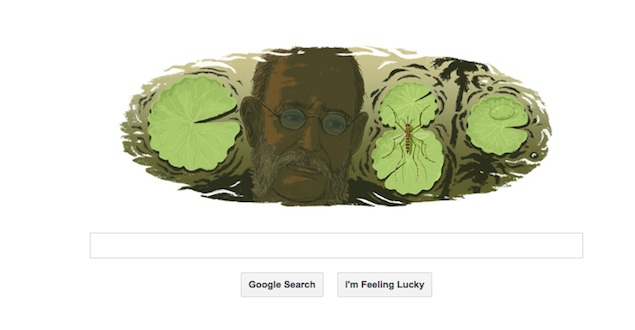- Home
- Others
- Others News
- Noted physician Carlos Juan Finlay remembered by Google doodle
Noted physician Carlos Juan Finlay remembered by Google doodle
By Anupam Saxena | Updated: 3 December 2013 13:00 IST

Advertisement
The 180th birth anniversary of Carlos Juan Finlay, Cuban physician and scientist known for his work on the treatment of yellow fever, has been marked with a Google doodle.
Tuesday's Google doodle features a portrait sketch of Carlos Juan Finlay, along with a representative image of the mosquito Culex fasciatus, now known as Aedes aegypti and vegetation in a water body, the surroundings where it breeds. Finlay had said that the Culex mosquito could be "hypothetically considered as the agent of transmission of yellow fever," in 1881.
Born in Puerto Principe, now known as Camaguey, Cuba, on 3 December 1833 as Juan Carlos Finlay y Barres, Finlay attended Jefferson Medical College in Philadelphia, Pennsylvania, and graduated in 1855. He pursued his education in Havana and in Paris, and later started practicing in Havana, where he settled.
He conducted research on yellow fever and its causes and origin. Yellow fever epidemics affected Cuba and particularly, Havana, leading to a large number of deaths. Carlos Juan Finlay authored 40 articles on the topic. Notably, he had also researched Cholera.
In 1881, Juan Finlay proposed that the Culex mosquito was the agent of transmission of yellow fever and that a mosquito stinging a victim of the disease could subsequently sting and infect a healthy person. His theory was not accepted widely, initially but was confirmed by Walter Reed in 1900. Finlay served as the chief health officer of Cuba from the years 1902 to 1909.
A monument had been erected honouring Finlay in the municipality of Marianao, in the city of Havana, as well as near the bayfront in Panama City.
Finlay was nominated seven times for the Nobel Prize in Medicine, but never won.
He died on 20 August 1915 in Havana, Cuba, due to a stroke said to be caused by severe brain seizures.
For more Google doodles, visit this page.

Best Google doodles of 2013
Tuesday's Google doodle features a portrait sketch of Carlos Juan Finlay, along with a representative image of the mosquito Culex fasciatus, now known as Aedes aegypti and vegetation in a water body, the surroundings where it breeds. Finlay had said that the Culex mosquito could be "hypothetically considered as the agent of transmission of yellow fever," in 1881.
Born in Puerto Principe, now known as Camaguey, Cuba, on 3 December 1833 as Juan Carlos Finlay y Barres, Finlay attended Jefferson Medical College in Philadelphia, Pennsylvania, and graduated in 1855. He pursued his education in Havana and in Paris, and later started practicing in Havana, where he settled.
He conducted research on yellow fever and its causes and origin. Yellow fever epidemics affected Cuba and particularly, Havana, leading to a large number of deaths. Carlos Juan Finlay authored 40 articles on the topic. Notably, he had also researched Cholera.
In 1881, Juan Finlay proposed that the Culex mosquito was the agent of transmission of yellow fever and that a mosquito stinging a victim of the disease could subsequently sting and infect a healthy person. His theory was not accepted widely, initially but was confirmed by Walter Reed in 1900. Finlay served as the chief health officer of Cuba from the years 1902 to 1909.
A monument had been erected honouring Finlay in the municipality of Marianao, in the city of Havana, as well as near the bayfront in Panama City.
Finlay was nominated seven times for the Nobel Prize in Medicine, but never won.
He died on 20 August 1915 in Havana, Cuba, due to a stroke said to be caused by severe brain seizures.
For more Google doodles, visit this page.
Best Google doodles of 2013
Comments
For the latest tech news and reviews, follow Gadgets 360 on X, Facebook, WhatsApp, Threads and Google News. For the latest videos on gadgets and tech, subscribe to our YouTube channel. If you want to know everything about top influencers, follow our in-house Who'sThat360 on Instagram and YouTube.
Further reading:
Carlos Juan Finlay, Google doodle
Popular on Gadgets
- Samsung Galaxy Unpacked 2025
- ChatGPT
- Redmi Note 14 Pro+
- iPhone 16
- Apple Vision Pro
- Oneplus 12
- OnePlus Nord CE 3 Lite 5G
- iPhone 13
- Xiaomi 14 Pro
- Oppo Find N3
- Tecno Spark Go (2023)
- Realme V30
- Best Phones Under 25000
- Samsung Galaxy S24 Series
- Cryptocurrency
- iQoo 12
- Samsung Galaxy S24 Ultra
- Giottus
- Samsung Galaxy Z Flip 5
- Apple 'Scary Fast'
- Housefull 5
- GoPro Hero 12 Black Review
- Invincible Season 2
- JioGlass
- HD Ready TV
- Laptop Under 50000
- Smartwatch Under 10000
- Latest Mobile Phones
- Compare Phones
Latest Gadgets
- Moto G15 Power
- Moto G15
- Realme 14x 5G
- Poco M7 Pro 5G
- Poco C75 5G
- Vivo Y300 (China)
- HMD Arc
- Lava Blaze Duo 5G
- Asus Zenbook S 14
- MacBook Pro 16-inch (M4 Max, 2024)
- Honor Pad V9
- Tecno Megapad 11
- Redmi Watch 5
- Huawei Watch Ultimate Design
- Sony 65 Inches Ultra HD (4K) LED Smart TV (KD-65X74L)
- TCL 55 Inches Ultra HD (4K) LED Smart TV (55C61B)
- Sony PlayStation 5 Pro
- Sony PlayStation 5 Slim Digital Edition
- Blue Star 1.5 Ton 3 Star Inverter Split AC (IC318DNUHC)
- Blue Star 1.5 Ton 3 Star Inverter Split AC (IA318VKU)
© Copyright Red Pixels Ventures Limited 2024. All rights reserved.












